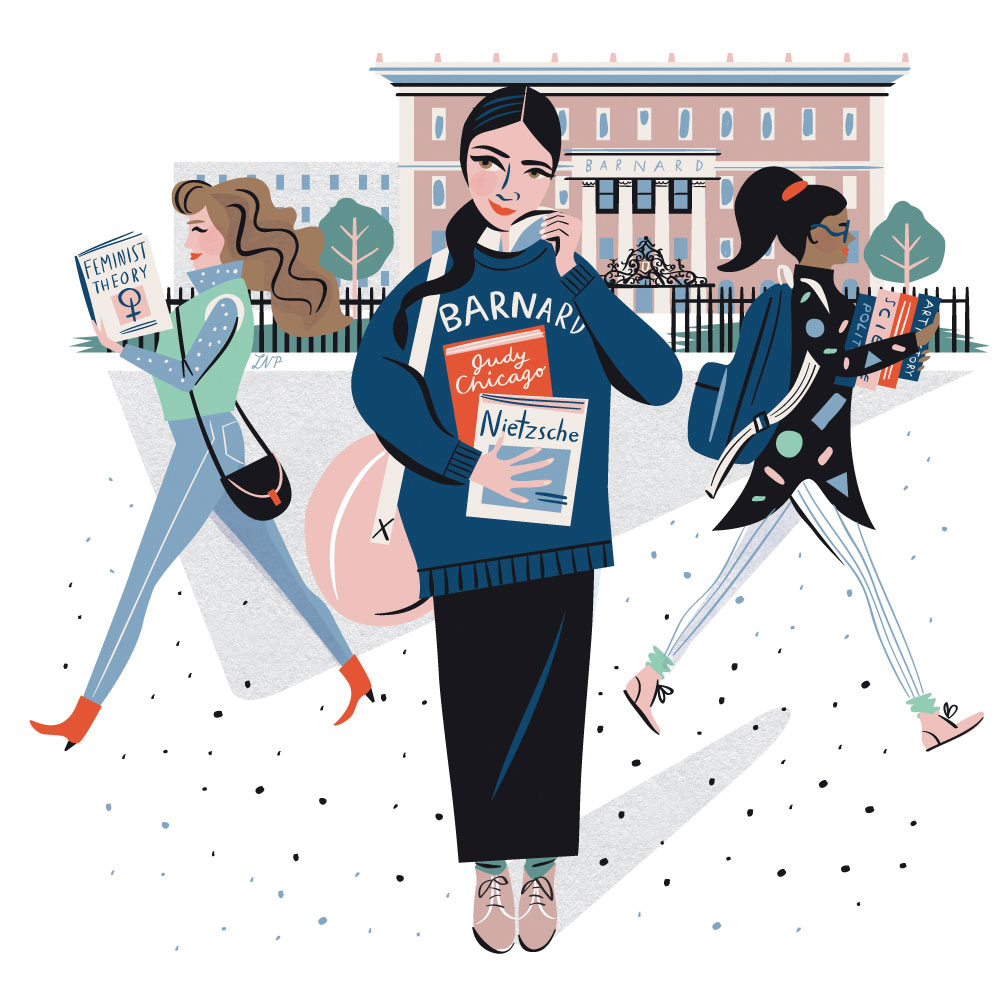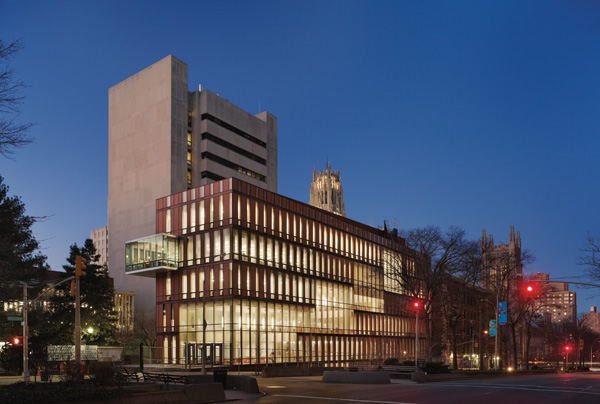Barnard is a small, highly selective liberal arts college for women located in New York City. The student body of just over 2,650 is part of a diverse and close-knit community and students study with leading scholars who serve as dedicated, accessible mentors and teachers. Founded in 1889, Barnard also engages in a unique partnership with Columbia University, situated directly across the street.
Students have access to cross-registration of courses with Columbia, many joint extracurricular activities, participate in NCAA Division I Ivy League athletics and enjoy a fully coed social life. The location in New York City grants students access to thousands of internship opportunities in addition to unparalleled cultural, intellectual and social resources. Barnard's diverse student body includes residents from nearly every state and more than 55 countries worldwide. About 40 percent of the student body identify as students of color, and 11 percent are non-US citizens or permanent residents. Barnard College is a highly selective liberal arts college for women located in the Morningside Heights neighboorhood of Upper Manhattan.
Columbia University is located directly across the street, and the two schools share many resources. Barnard and Columbia students can take classes at both schools, share the holdings of the 22 affiliated libraries, and compete in the joint athletic consortium. But unlike the now-defunct Harvard / Radcliffe relationship, Columbia and Barnard have separate financial resources, admission offices, and staffing.
Barnard is one of a handful of outstanding colleges exclusively for women. The entrance standards at Barnard are very tough, but the Admissions process is definitely less competitive than Columbia's. For example, though Barnard matriculates about 550 students per year, it admits 23% of its applicants. Columbia, by contrast, only accepts about 7% of its applicants! Now once enrolled, Barnard and Columbia seemingly intersect everywhere.
Note that they do NOT share dorms, but the Freshman orientation program is completely co-mingled. So yes, I would probably recommend that a student who is in love with Columbia, but not quite qualified to be in the top 25% of the Columbia applicant pool look seriously at Barnard. They are both elite with incredible and strong alumni networks . For those who qualify (academically and 'financially) and fit , either school is a winner.
As of 2012 Barnard pays Columbia about $5 million a year under the terms of the "interoperate relationship", which the two schools renegotiate every 15 years. Despite the affiliation Barnard is legally and financially separate from Columbia, with an independent faculty and board of trustees. It is responsible for its own separate admissions, health, security, guidance and placement services, and has its own alumnae association. Nonetheless, Barnard students participate in the academic, social, athletic and extracurricular life of the broader University community on a reciprocal basis.
The affiliation permits the two schools to share some academic resources; for example, only Barnard has an urban studies department, and only Columbia has a computer science department. Most Columbia classes are open to Barnard students and vice versa. Barnard students and faculty are represented in the University Senate, and student organizations such as the Columbia Daily Spectator are open to all students.
Barnard students play on Columbia athletics teams, and Barnard uses Columbia email, telephone and network services. Founded in 1889 as a women's college when Columbia University was still an all-male institution, Barnard College is now an independent college under the Columbia umbrella. It is fully autonomous, with its own admissions process and curriculum requirements, but Barnard and Columbia students can freely take classes on each other's campuses and participate in clubs. Founded in 1889 as a college for women closely affiliated with the then all-male Columbia University, Barnard College is a self-sustaining entity under the Columbia umbrella.
While we each have our own curriculum requirements, admissions and financial aid processes, and unique student experiences, Barnard and Columbia share a lot. Students can attend classes at both campuses and participate in each other's clubs and events. We're two distinct communities, across-the-street partners that create a larger whole. Through an agreement with List College of the Jewish Theological Seminary, located just north of the campus at 122nd Street, students can apply to simultaneously earn a BA degree from Barnard and a BA at JTS.
Barnard also offers highly-talented music students the opportunity to apply for the Lesson Exchange Program with Juilliard and/or the Cross Registration Program with the Manhattan School of Music. Both programs will require a separate application and audition. The Lesson Exchange at MSM and Juilliard provide private weekly lessons with faculty. It is important to note that the Exchange does not include participation in large ensembles. Students in the Juilliard program can take classes in instrumental or vocal performance and piano composition. MSM students can take lessons for instrumental or composition only.
Barnard does also offer a multitude of music courses, major, private lessons and many performance opportunities through its own music department and at Columbia. It is a liberal arts college but because of Columbia across the street Barnard students get both a small community and a larger university. And in all honesty, Barnard truly does feel like a little more independent undergraduate college of Columbia University, it's a pretty close relationships.
It's rare to find a Barnard student who doesn't express what she feels articulately in a class. "Small liberal college in the best city in the world with all the perks of a big university across the street," is exactly what admissions office will tell you and they're right. If you love the city, but still want a campus that feels like home... If you want to be surrounded by the most intelligent, driven women you'll ever meet in your life... If you want all the resources of a huge university, but the care and attention of a small school...
If you want a solid liberal arts base, but the opportunity for great work experience during your time in college... If you want to feel like you're part of a greater legacy and network of alumnae... On the topic of Barnard using its relationship to Columbia as a marketing scheme, I can't say, however I will mention that my impression of the relationship as a prospie vs now is quite different.
In fact, now I feel that the schools are so much more intertwined that I had believed before. While I am proud of my identity as a Barnard Student, and very happy with my school choice, I've also found that my identity within the Columbia community is just as significant. There is much less differentiation within classes and social settings that one might assume, and I feel like the students of all four undergraduates are my peers. However, I will admit that lack of access to JJ's and the separation of the schools during NSOP left me confused upon my entry into the community. I feel the relationship is much less about the resources provided to Barnard and much more about the fact that every student here chose their school for significant, personal reasons.
The college you choose is all about what your best fit, that is why admissions is so holistic, and that is why it is important that CU has multiple unique undergraduate schools. Barnard College, one of the Seven Sisters schools, was founded in 1889 ; it remains an undergraduate liberal arts school for women only. The college was named for Columbia's 10th president, Frederick Barnard, whose campaign to have women admitted to Columbia resulted in a Collegiate Course for Women in the early 1880s. Women completing the curriculum were awarded a diploma from Columbia, but they had to pursue their courses of study independently. The program was soon abandoned, leading to the establishment of Barnard.
The college moved to its present location, across the street from Columbia in the Morningside Heights section of Manhattan, in 1898. Barnard College considers the residential experience to be an integral part of a student's total education. Students who live on campus have a more productive and more satisfying college experience than those who live off campus.
Students who live in campus housing are close to academic buildings, libraries, and dining facilities. Trained, professional Residential Life & Housing staff members are present to provide social & academic programs and help in emergency situations. Additionally, living on campus provides access to amenities like internet access, laundry rooms, computer labs, music practice rooms, and study lounges. Students are not required to live on campus; however, students are encouraged to live on campus for at least their first year in order to acclimate to the campus and to New York City. 98% of Barnard First-Year students live on campus and over 90% of students overall.
Throughout the 1980s, Barnard struggled to keep its admissions numbers competitive. By the early 1990s, they appeared to have weathered the storm. President Ellen Futter and her successor, Judith Shapiro, launched major fundraising campaigns during their tenures. In addition, the Barnard admissions office emphasized studies that showed that female students who attended all-women schools were better able to reach their academic potential than those who attended coeducational institutions. By 1998, Barnard application numbers were rising at a rate of 117 percent in one year, and the school's acceptance rate had dropped to a competitive thirty-three percent.
I liked the balance between having an entire city at my doorstep and having the quiet, intimate retreat of the Barnard campus to come back to. The campus is physically very small, but it doesn't feel this way, because you have access to space, activities, and resources across the street at Columbia. One potentially uncomfortable aspect of going to Barnard is the ambiguous relationship between Barnard and Columbia, which the administration does a pretty poor job of defining.
When I tell people I went to Barnard, I often get the question, "Oh, so, is that like, the same thing as Columbia?" The answer I give them is no, it's not, it is its own college with its own philosophy of higher education. But, being affiliated with Columbia University, it offers students the opportunity to take Columbia courses, participate in Columbia student groups, use the Columbia libraries, and just hang out on the Columbia campus. The way I see it, every student can choose her own balance between Barnard and Columbia life and find some satisfying meeting point between the two worlds.
Is Barnard As Prestigious As Columbia It's a great liberal arts college focused on goal oriented women's success. All of the administration wants to help and be accessible to the students. Barnard students, for the most part, while having a competitive edge, want to help each other. People think it's great when you tell them you go to Barnard, although initially between Columbia College Students and Engineering students, there may be a little tension. I don't spend all of my time on campus, there's lots to do in the city, and I view seeing the city as part of my education.
Barnard and Columbia have their own housing stock and housing systems. Barnard and Columbia College/SEAS undergrads have historically not had swipe access to each others residence halls. Students on both sides of the street have varying opinions on this policy. Other students from both CC/SEAS and Barnard believe that neither of the two undergraduate populations should have access to the other's dorms. The two student populations belong to separate schools, these students argue, and thus each should only have access to their own dorms and the resources therein.
Finally there are students, both from Barnard and CC/SEAS, who believe that all the undergraduates within Columbia University should have access to each other's dorms. Students of this view generally argue that the two student populations are not really separate and that it is inconvenient for both Barnard and CC/SEAS students to not be able to swipe into each others dorms. Simply put, Barnard is institutionally independent, while academically and socially linked to Columbia. There are few freebies between the school- Barnard has to pay Columbia for access to utilities, the libraries, and other facilities such as Lerner. Columbia University does not handle admissions for Barnard, nor does it spend money on or collect money from Barnard students.
Nevertheless, both student bodies typically benefit in some manner when either school spends money, as the schools tend to keep student programming open to all undergraduates, though this is not always the case. Columbia University, major private institution of higher education in New York, New York, U.S. It is one of the Ivy League schools. Founded in 1754 as King's College, it was renamed Columbia College when it reopened in 1784 after the American Revolution. Columbia College was the undergraduate liberal arts school for men until 1983, when women began to be admitted.
Besides Columbia College, the university includes two other undergraduate schools and the affiliated Barnard and Teachers colleges. Luckily, unlike some Seven Sisters schools and other all-women liberal arts colleges in the country, students at Barnard are not required to live on-campus. This means that they can deduct $15,691 from the sticker price if they wish to live elsewhere, bringing the total cost from $76,279 down to $60,588. The average SAT score of students admitted into Barnard College is 1404. On the other hand, the average ACT score of students admitted into the school is 31. The need to have high SAT or ACT scores is one of the things that make the school one of the most selective liberal arts colleges in the nation.
Barnard is amazing because it is a small liberal arts college with an abundant of resources, services, and support. It gives students the best of both worlds- a huge research university experience and a small student-centered liberal arts college experience. The community on campus is warm and welcoming, and the intellectual debate and dialogue is rigorous and stimulating. There is a ton of school pride, and most students are thrilled to be here and love it. Just as the admissions office will tell you over and over - Barnard is the best of both worlds, a small college in a big city. Some people spend most of their time in the Barnard/Columbia/Morningside Heights area while others prefer to spend more time adventuring into the New York.
The community can be what you make of it, if you want to find a large, close-knit, group of friends you will be able to. If you prefer to have one or two close girl friends, you can do that to. The community is a good size, Barnard is small but if you ever feel claustrophobic, Columbia is a much larger community right across the street. Most people hangout on campus in the dorms, or in the Diana Center .
A lot of people also choose to hangout at Columbia, in the libraries or the student center over there. Barnard has a lot of "Barnard Women" pride, but not a lot of pride in the traditional sense. If you really want a rah-rah campus with tons of pride for athletic events and school-sponsored functions, Barnard/Columbia is not the place for you. I love pretty much everything about Barnard, I think its great that you can get the benefits of a women's college without having to sacrifice men.
This starts with the admissions process; it is a simple statistical truth that the average Columbia student is stronger academically due to being selected more rigorously during applications. There are many Barnard students that are stronger that the average Columbia student, but the mean of the Columbia distribution is undoubtedly higher. This is a signal to employers and further institutions that has nonnegligible value. It also flattens the relationship between Barnard and Columbia into a two-dimensional plane. Ever since Columbia College, the largest undergraduate program at the university, started accepting women as late as 1983, Barnard's already integrated relationship with Columbia has become even more intertwined.
I was able to take a Barnard class on their formal campus because of the Intercorporate Agreement, which allows Barnard and Columbia students to cross-register between undergraduate offerings from both schools. And for students interested in theater or urban studies, you have no choice but to study at Barnard. Barnard is only the second woman's college that I have visited. If I were to compare the two, I would say that both schools take very similar approaches to developing women not only for careers and further education, but also for leadership. Both communities have the right examples of women as leaders within their administrations, their faculty and their student bodies. They also do an excellent job at preparing women for careers in the sciences.


























